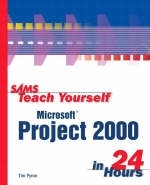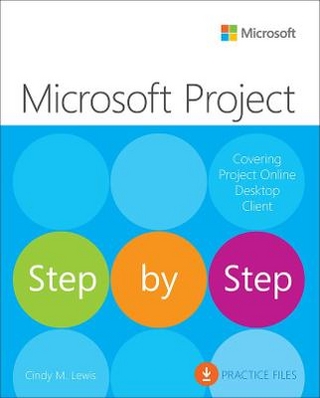
Sams Teach Yourself Microsoft Project 2000 in 24 Hours
Sams Publishing (Verlag)
978-0-672-31814-6 (ISBN)
- Titel ist leider vergriffen;
keine Neuauflage - Artikel merken
Tim Pyron is an information systems manager for Productivity Point International in San Antonio, TX, a leading provider of computer training ad support services in North America. He provides consulting services and conducts training in Microsoft Project and in spreadsheet and database applications. Tim's previous Microsoft Project books include Sams Teach Yourself Microsoft Project 98 in 24 Hours and Special Edition Using Microsoft Project 98.
Introduction.
Is This the Book for You? How This Book Is Organized. Conventions Used in This Book.
I. GETTING STARTED WITH A PROJECT.
1. Getting Started with Microsoft Project 2000.
The Life Cycle of a Project. Using Project 2000's Tutorials and Help Features. Exploring the Microsoft Project Window. Understanding Views. Exiting Microsoft Project 2000. Summary. Q&A. Exercises.
2. Becoming an Instant Project Guru.
Practicing with a Sample File. Understanding What You See. Working with the Timeline. Working with the Task Table. Viewing More Task Details. Summary. Q&A. Exercises.
3. Starting a New Project and Working with Tasks.
Things to Do When Starting a New Project File. Starting a New Project File. Starting the Task List. Editing the Task List. Arranging Tasks with an Outline. Entering Recurring Tasks. Copying a Task List from Another Application. Getting a Simple Printout of the Task List. Saving the New File. Summary. Q&A. Exercises.
II. DEVELOPING A TIMELINE.
4. Starting the Scheduling Process.
Understanding How Default Dates Work. Understanding How Tasks are Scheduled. Setting the Start or Finish Date for the Project. Estimating Task Duration. Summary. Q&A. Exercises.
5. Defining When Project Can Schedule Tasks.
Elements of Project Scheduling. Adjusting the Default Working Day. How Calendars Are Used in Scheduling. Creating and Applying Base Calendars for Special Scheduling Needs. Managing Your Calendars. Summary. Q&A. Exercises.
6. Linking Tasks in the Correct Sequence.
Linking Tasks. Creating and Modifying Task Links. Working with the Automatic Linking Option. Reviewing Your Task Links. Summary. Q&A. Exercises.
7. Working with Deadlines and Constraints.
Working with Constraints. Resolving Conflicts Caused by Constraints. Splitting Tasks. Recording Deadlines. Summary. Q&A. Exercise.
III. DISPLAYING AND PRINTING YOUR SCHEDULE.
8. Working with Other Task Views.
Exploring the Calendar View. Moving Around in the Calendar View. Using Filters to Clarify the Calendar View. Viewing Task Details in Calendar View. Editing a Project in the Calendar View. Exploring the Network Diagram View. Zooming the Network Diagram View. Viewing Outline Levels in the Network Diagram. Applying Filters to the Network Diagram. Scrolling and Selecting in the Network Diagram. Editing a Project in the Network Diagram. Summary. Q&A. Exercises.
9. Formatting Views.
Using the General Format Options. Special Formatting for the Gantt Chart. Special Formatting for the Calendar. Special Formatting for the Network Diagram. Summary. Q&A. Exercises.
10. Finalizing and Printing Your Schedule.
Checking for Spelling Errors. Printing Views. Printing the Overview Reports. Summary. Q&A. Exercises.
IV. ASSIGNING RESOURCES AND COSTS TO THE TASKS.
11. Defining Resources and Costs.
Improving the Accuracy of the Schedule. Controlling Costs. Defining Your Resources and Costs. Creating the Resource Pool. Using the Assign Resources Dialog Box to List Resources. Using the Resource Sheet. Using the Resource Information Dialog Box. Printing the Resource Pool. Summary. Q&A. Exercises.
12. Mastering Resource Scheduling in Microsoft Project.
Choosing to Enter Resource Assignments. Defining the Resource Assignment Fields. Understanding the Work Formula. Using the Task Type to Control Calculations. Applying the Work Formula in a Material Resource Assignment. Assigning Multiple Resources To a Task. Understanding How Project Calculates Effort-Driven Tasks. Summary. Q&A. Exercises.
13. Assigning Resources and Costs to Tasks.
An Overview of Creating Assignments. Choosing the Task Settings for Assignments. Assigning Resources to Tasks. Assigning Resources with the Task Form. Using the Assign Resources Dialog Box. Assigning Fixed Costs and Fixed Resource Fees. Summary. Q&A. Exercises.
14. Editing Resource Assignments.
Working with the Task Usage View. Editing Assignments with the Task Usage View. Editing Assignments with the Assignment Information Dialog Box. Changing the Cost Rate Table for an Assignment. Introducing Delay in an Assignment. Splitting Tasks and Task Assignments. Contouring Resource Assignments. Assigning Overtime Work. Understanding the Effects of Changing Task Duration. Summary. Q&A. Exercises.
15. Resolving Resource Allocation Problems.
How Do Resource Overallocations Happen? Identifying Overallocated Resources. Eliminating Resource Overallocations. Letting Project Level Overallocated Assignments. Summary. Q&A. Exercises.
V. FINALIZING AND PUBLISHING YOUR PLAN.
16. Fine-Tuning the Project Plan.
Looking at the Big Picture. Filtering Tasks or Resources. Sorting and Grouping Tasks and Resources. Shortening the Critical Path. Reducing Costs. Summary. Q&A. Exercises.
17. Printing Resource Details and Customizing Reports.
Formatting and Printing the Usage Views. Working with Cost Reports. Working with the Assignment Reports. Using the Workload Reports. Customizing the Standard Reports. Customizing Specific Report Types. Summary. Q&A. Exercises.
18. Creating Custom Views.
Creating Custom Tables. Creating Custom Views. Creating Custom Fields. Summary. Q&A. Exercises.
19. Publishing Projects on the Web or an Intranet.
Overview of Project 2000's Internet Features. Navigating with Hyperlinks. Exporting Project Data to Web Pages. Defining Import/Export Map HTML Options. Working with Hyperlinks in Tasks and Resources. Publishing Your Web Documents. Summary. Q&A. Exercises. Hour.
VI. MANAGING AND TRACKING YOUR PROJECT.
20. Tracking Work on the Project.
Using Project as a Management Tool. Understanding the Tracking Fields. Setting the Baseline. Tracking Actual Performance. Summary. Q&A. Exercises.
21. Analyzing Progress and Revising the Schedule.
Analyzing Variances and Revising the Schedule. Analyzing Progress. Updating the Schedule. Revising the Schedule to Finish on Time and on Budget. Summary. Q&A. Exercises.
VIII. BEYOND ONE PROJECT, ONE APPLICATION.
22. Working with Multiple Projects.
Consolidating Projects into One Window. Consolidating Inserted Projects. Sharing Resources among Projects with a Resource Pool. Summary. Q&A. Exercises.
23. Using Microsoft Project in Workgroups.
Exploring Project's Workgroup Features. Deciding on Email, Intranet, or Internet Workgroup Communications. Setting Up Project Messaging. Sending Task Requests with TeamAssign. Requesting and Submitting Task Progress with TeamStatus. Sending Task Updates with TeamUpdate. Setting Task Reminders. Circulating the Project Schedule for Review. Sending Schedule Notes. Summary. Q&A. Exercises.
24. Exchanging Project Data with Other Applications.
File Formats Supported by Microsoft Project 2000. Exporting Project 2000 Data to Older Releases of Microsoft Project. Saving the Entire Project in a Database. Using Import/Export Maps to Exchange Project Data with Other File Formats. Copying Selected Data between Applications. Linking Selected Data Between Applications. Summary. Q&A. Exercises.
| Erscheint lt. Verlag | 11.5.2000 |
|---|---|
| Verlagsort | Indianapolis |
| Sprache | englisch |
| Maße | 231 x 185 mm |
| Gewicht | 957 g |
| Themenwelt | Informatik ► Office Programme ► Project |
| Wirtschaft ► Betriebswirtschaft / Management ► Projektmanagement | |
| ISBN-10 | 0-672-31814-8 / 0672318148 |
| ISBN-13 | 978-0-672-31814-6 / 9780672318146 |
| Zustand | Neuware |
| Informationen gemäß Produktsicherheitsverordnung (GPSR) | |
| Haben Sie eine Frage zum Produkt? |
aus dem Bereich
